Microsoft Surface Pro 3 Review
by Anand Lal Shimpi on June 23, 2014 3:55 AM ESTDisplay Analysis
I published an analysis of Surface Pro 3's display shortly after receiving my review unit. For those of who you haven't seen it already, the results and analysis are reprinted below.
With Surface Pro 3, Microsoft finally accepts that while 16:9 may be a great aspect ratio for watching movies but it's not optimal for a multi-purpose tablet. The tablet features a 12" 2160 x 1440 display (RGB stripe, not RGBW/PenTile), which ends up being a 3:2 aspect ratio. The difference is immediately noticeable in notebook-style use. While the Surface Pro 2 was never quite all that comfortable to use as a laptop, Surface Pro 3's display makes it substantially more laptop-like. There doesn't appear to be a big impact to tablet use either with the larger display. Particularly with Windows 8.1's split screen mode, the larger display ends up working extremely well. The LCD continues to be laminated to the cover glass just like with previous Surfaces.
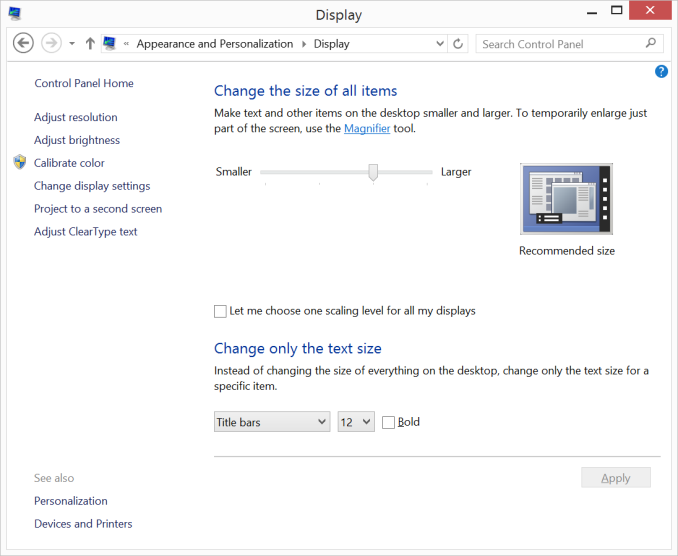
Default 150% Scaling on Surface Pro 3, the 2160 x 1440 display behaves like a HiDPI 1440 x 900 display
Color accuracy is improved out of the box as well. The original Surface Pro had a display capable of being quite accurate, if calibrated, but out of the box it was a bit of a mess. Microsoft slowly improved out of box calibration over the years, eventually culminating in what we have today with Surface Pro 3.

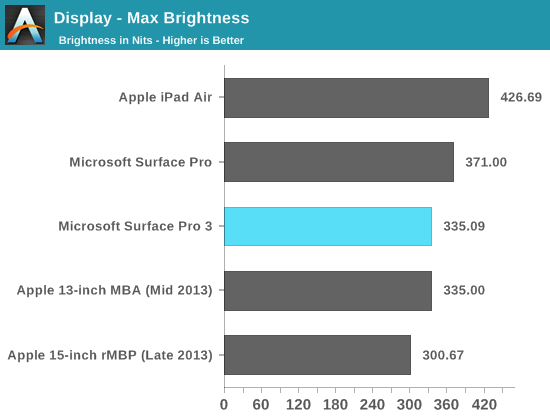
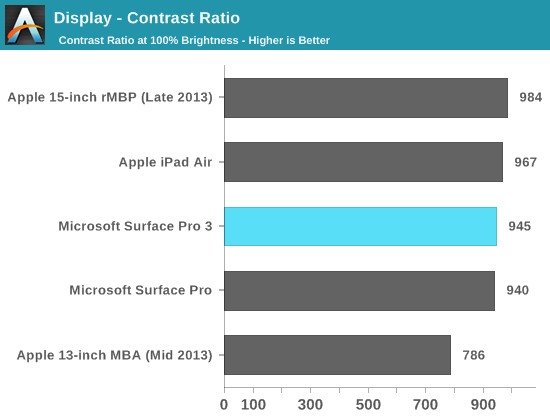
Max brightness drops a bit compared to Surface Pro 2, likely due to the Pro 3 having 50% more pixels to light. Black levels at max brightness are pretty good, thanks in part to Microsoft's optically bonded LCD/cover glass stack. Contrast ratio remains competitive with previous designs.
Grayscale accuracy is the biggest issue with the new display, green levels are just way too high:
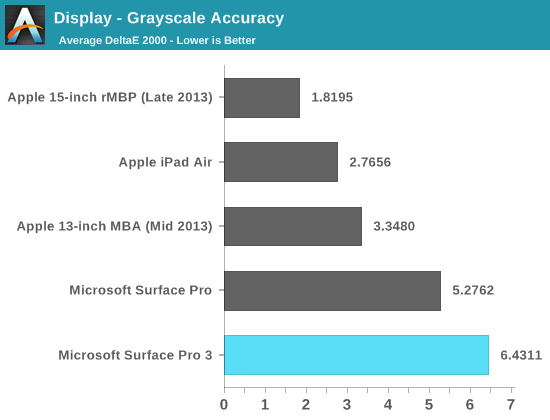
Our basic sRGB gamut test paints a great picture for Surface Pro 3. Full saturation color reproduction is excellent:
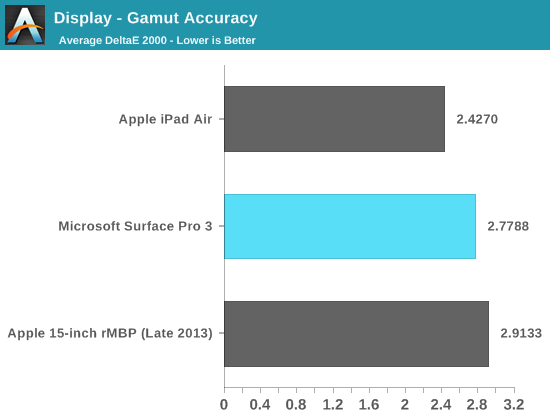
The saturation sweep also looks solid:
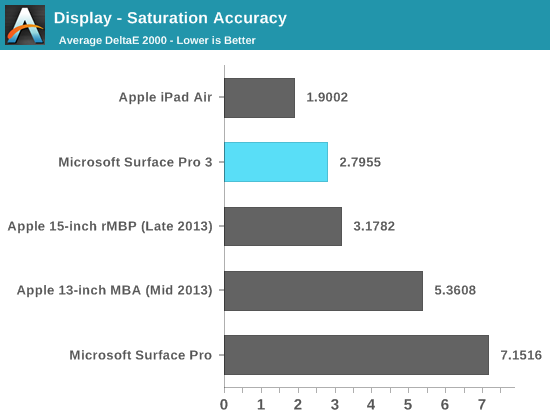
Unfortunately Surface Pro 3 doesn't do so well on our GMB color checker test. Part of the problem is its performance in the grayscale swatches included in this test:

Overall the Surface Pro 3 display is a huge improvement over the previous two generations, but it doesn't quite meet the high standards set by some of the other competitors on the market today from both notebook and tablet spaces.


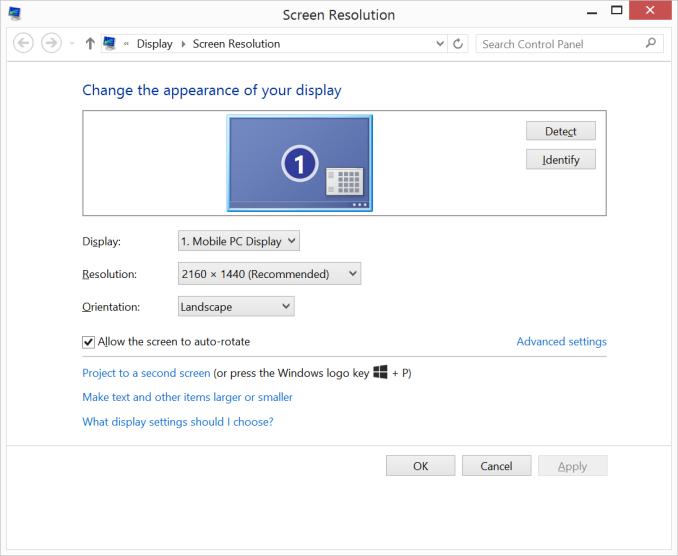



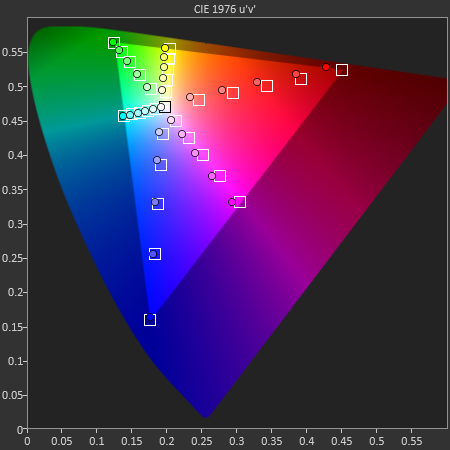










274 Comments
View All Comments
Antronman - Monday, June 23, 2014 - link
The i7's the Surface Pro 3 will come out with have HD5000.andrewaggb - Monday, June 23, 2014 - link
wonder how much it'll matter if it's throttling heavily. Might make a huge difference if the eu's are all active, just clocked low. guess we'll have to see.mkozakewich - Monday, June 30, 2014 - link
Plus you can use an external cooling system to get more power out of it. I'm wondering if they'll add cooling to their docks at some point.Aqua1ung - Monday, June 23, 2014 - link
Can you install Ubuntu/Linux on this?nerd1 - Monday, June 23, 2014 - link
If you don't mind having ZERO touchscreen and HiDPI support. I am just using VM for now.anonymous_user - Monday, June 23, 2014 - link
So the touchscreen doesn't work at all with Linux? Even just to click things (no swiping)?nerd1 - Monday, June 23, 2014 - link
So far the type cover doesn't seem to be recognized - you may still plug in USB keyboard and mouse, and run ubunutu at native resolution (Surprisingly, the native resolution looks good to me!)prashy21 - Monday, June 23, 2014 - link
Gr8 job Anand, right on the money, I just picked up the Surface pro 3 couple of days ago and I feel it is Microsoft software which is holding it back.smartypnt4 - Monday, June 23, 2014 - link
Any chance of seeing the battery life numbers re-run on the i3 version when it becomes available? I'd be really interested in how a Y-series SKU changes the battery life and maybe even the thermals of the device. I doubt it'll have a huge effect, but still, the analysis would be good to see.pjcamp - Monday, June 23, 2014 - link
That's an awful lot of engineering to get around the fact that a kickstand is just a bad idea. It works on a table and is compromised everywhere else. Which probably means all the original design work occurred in conference rooms and no one noticed. Now they're trying to fix the oversight.This does indeed seem better than previous implementations but the Transformer-type solution, with a rigid keyboard rigidly attached (and space battery) still makes more sense to me.